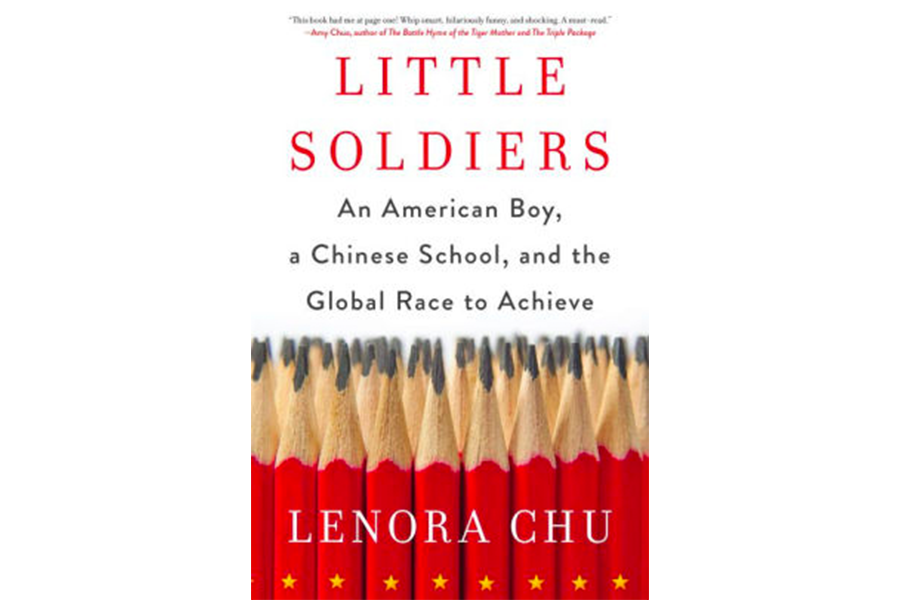'Little Soldiers' examines the Chinese education system from the inside
Loading...
Born in Philadelphia, reared in a Houston suburb, Stanford- and Columbia-educated, journalist Lenora Chu has a resume that – at first glance – looks very American. But her “connection to China came by birthright”: she’s “a direct descendant of the founding emperor of the Ming dynasty.” Chu’s parents’ families fled China’s Cultural Revolution, with her mother and father separately arriving in the United States as “youngsters.” Both earned Ivy League PhDs and raised their two daughters “under the invisible hand of ancestral expectation” that assumed academic achievement.
A half-century since the most learned Chinese citizens suffered (and died) during Mao's anti-intellectual purges, the irony is that contemporary China – at least in its urban centers – now sits at the pinnacle of academic achievement. In 2010, “Shanghai teenagers scored tops in the world in math, reading, and science,” according to PISA (Program for International Student Assessment), a global student assessment test; US students were firmly “middle of the pack."
Four months before the stellar results hit international newsfeeds, Chu had moved to Shanghai from Los Angeles with her husband, NPR’s Shanghai correspondent Rob Schmitz, and their toddler son Rainey. “What I was reading in the newspapers didn’t exactly sync with my experiences,” Chu noted.
Her “journalistic curiosity” – developed as a reporter in New York, Minnesota, and California – “kicked in.” The result is her debut, Little Soldiers: An American Boy, a Chinese School, and the Global Race to Achieve. Her status as “a special kind of foreigner” – one who speaks Mandarin, albeit with a Texas drawl, who’s “returned to the bosom of the motherland” – gave Chu privileged access, further enhanced by Rainey’s admission into one of Shanghai’s most prestigious kindergartens – “the school, as far as posh Chinese urbanites were concerned.”
The apprehensions Chu and her husband would come to feel about Rainey’s education began almost immediately. He’s rewarded not for outstanding performance but for sitting absolutely still. He parrots Communist Party songs. He asks for silence during dinner because his school lunchtimes don’t allow talking.
The “troubling signs” multiply. Rainey is force-fed eggs, publicly shamed, threatened with lies, and even blatantly brainwashed, all to the end of creating “little soldiers.” And yet Rainey also gains resilience and responsibility beyond his years, not to mention his early facility in math and language (first- and second-graders, for example, recognize 1,600 characters; full literacy requires 3,500 characters). The East/West divide proves vast, but Chu recognizes the need for flexibility: “If we opened our minds, we just might reap the benefits of rearing our child in a second culture, and educating him the Chinese way (while hopefully retaining our Western sense of individuality).”
Beyond documenting her family’s hybrid experiences, Chu takes “pen and paper everywhere,” visiting classrooms in China and the US, meeting other Chinese students, following education-seeking Chinese families. Her research culminates in three major areas: “The System,” highlighting Chinese educational practices, including education as “a family affair” in which a child can often have six adult overseers with two parents and four grandparents; “Change,” which examines the “high price” of a test-based system, the government’s attempts at system overhauls, the immense discrepancy between urban and rural educations (the high school dropout-rate outside cities is almost 50 percent!), and rampant cheating and bribery; and “Chinese Lessons” which considers the many activities supporting stellar achievement, including rote memorization, which can actually enable and encourage deeper thinking and unrestrained creativity.
Undoubtedly revealing, fascinating, and filled with "aha" moments, “Little Soldiers” is not without pitfalls. One extremely pertinent experience that seems surprisingly elided is Chu’s volunteer-teaching in Shanghai, merely mentioned a few times with minimal explication. Also clumsily presented is the appearance of a second son, initially alluded to when introducing Chinese naming customs: the character for Rainey’s Chinese name is “[s]tone times three” meaning “open” and “honest”; Landon’s is “[g]old times three” meaning “profit” and “prosperity.” Little else is revealed about Landon until his rejection at age 2 from Rainey’s elite kindergarten.
While Rainey is admittedly a clever, charming subject, Chu’s narrative overall would have been strengthened by giving more attention to the students she meets, especially those she encounters in her exploratory rural jaunts, as well as further scrutiny of the challenges facing a migrant couple and their struggling son – and additional families like them.
“When the negatives outweigh the positives, we will alter course,” Chu muses about her family’s decision to keep Rainey in the Chinese school system as he transitions to primary school. Her eventual hope/demand/call for “that exact middle” of both East and West educational systems feels like an abrupt, too-easy ending at best. Pressing questions about education and achievement remain; Chu’s explorations here will surely inspire savvy readers to keep seeking answers, long after the final page.
Terry Hong writes BookDragon, a book blog for the Smithsonian Asian Pacific American Center.






